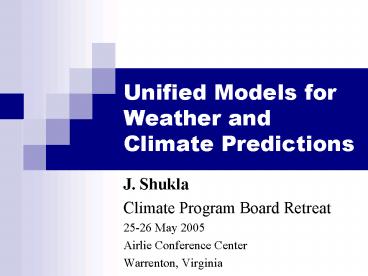Unified Models for Weather and Climate Predictions - PowerPoint PPT Presentation
1 / 29
Title:
Unified Models for Weather and Climate Predictions
Description:
5-day forecast. Initialization 12z 11September ... efficiency, this 5-day forecast was done in ... Increasing the skill of global high-impact weather forecasts ... – PowerPoint PPT presentation
Number of Views:140
Avg rating:3.0/5.0
Title: Unified Models for Weather and Climate Predictions
1
Unified Models for Weather and Climate Predictions
- J. Shukla
- Climate Program Board Retreat
- 25-26 May 2005
- Airlie Conference Center
- Warrenton, Virginia
2
(No Transcript)
3
(No Transcript)
4
Advances in weather and climate prediction
require a balanced program of observations,
modeling and applications to society
5
(No Transcript)
6
Improvement in medium-range forecast
skill 12-month running mean of anomaly
correlation () of 500hPa height forecasts
7
Nastrom and Gage, 1985 A climatology of
atmospheric wavenumber spectra of wind and
temperature observed by commercial aircraft. J.
Atmos. Sci., 42, 950960.
8
Vintage 1980 AGCM (Lau, 1997, BAMS
9
Vintage 2000 AGCM
10
Evolution of Climate Models 1980-2000 Model-simul
ated and observed rainfall anomaly (mm day-1)
1983 minus 1989
11
Evolution of Climate Models 1980-2000 Model-simul
ated and observed 500 hPa height anomaly (m)
1983 minus 1989
12
(No Transcript)
13
(No Transcript)
14
Variance of Model-Simulated Seasonal (JFM)
Rainfall (mm2)
15
WCRP Projects
WGNE WGCM
16
2005 after 25 years of WCRP
New overarching and integrating Strategic
Framework Prediction of entire climate
system (Earth System) FGGE ? extended
weather prediction TOGA ? seasonal
prediction (tropics) COPES ? climate system
prediction
17
(No Transcript)
18
(No Transcript)
19
(No Transcript)
20
(No Transcript)
21
Land-Climate Interaction
- Soil wetness, vegetation, and snow
- Local modification of remote SST effects
- Enhanced predictability of circulation Ts
- Predictability of water cycle
22
linear trend R2 0.4
23
Weather Prediction Model of 2020
- Coupled Ocean-Land-Atmosphere Model
1 km x 1 km 100 levels Unstructured, adaptive
grids
Landscape-resolving (100 m)
1 km x 1 km 50 levels Unstructured, adaptive
grids
Assumption Computing power enhancement by a
factor of 103-104
24
Convective prec. at T511
T2047
25
Hurricane Ivan (2004) 5-day forecast
- Initialization 12z 11September
- Observed center pressure prior to landfall 930
hPa at 00Z16Sept - Predicted center pressure at that time 930 hPa
- Observed wind prior to landfall category 4
hurricane - Predicted wind category 4 (60m/s)
- Displacement error 50km
- Thanks to the high computational efficiency, this
5-day forecast was done in about one hour using
240 CPUs of one node of the Columbia ALTIX
Shading 850 wind speed (m/s) Contour sea level
pressure (hPa)
26
Modeling and Computing
- Models in 2015
- Weather
- T3800 (5 km) 4 d/hr (2,160 CPUs)
- - or -
- T825 (25 km) 4 d/hr (468 CPUs)
- Climate
- T420/ 0.5 2.4 yrs/d (2,500 CPUs)
- -or-
- T420/0.5 2 mo/d (2,500 CPUs)
- Models Today
- Weather
- T254 5 d/hr on 144 CPUs
- T511 2.5 d/hr on 288 CPUs
- Climate
- T85/ 1 2.0 yrs/d on 96 CPUs
- 2X2.5/1 5.25 yrs/d on 180 CPUs
43/yr (Moores Law ) -OR- 10/yr
27
Unified Global Weather and Climate Prediction
System for the 21st Century
- Increasing the skill of global high-impact
weather forecasts - Reducing the uncertainty of climate prediction
- Improving intraseasonal predictions of floods and
droughts - Designing, implementing and utilizing GEOSS data
sets - Assimilating high resolution data
- Enabling interactions of the physical climate
system and the chemistry and biology of planetary
ecosystems - Helping policy-makers and stakeholders in
scale-appropriate decision-making for mitigation
and sustainable development for the benefit of
society and the health of the planet - Assumption Eliminating parameterizations of
large-scale convection and resolving small-scale
variations will enhance the predictability of
models
28
Concluding Remarks
- The largest obstacles in realizing the potential
predictability of weather and climate are
inaccurate models and insufficient observations,
rather than an intrinsic limit of predictability. - In the last 30 years, most improvements in
weather forecast skill have arisen due to
improvements in models and assimilation
techniques
29
Concluding Remarks
- The largest obstacles in realizing the potential
predictability of weather and climate are
inaccurate models and insufficient observations,
rather than an intrinsic limit of predictability. - In the last 30 years, most improvements in
weather forecast skill have arisen due to
improvements in models and assimilation
techniques - The next big challenge is to build a hypothetical
perfect model which can replicate the
statistical properties of past observed climate
(means, variances, covariances and patterns of
covariability), and use this model to estimate
the limits of weather and climate predictability - The model must represent ALL relevant phenomena,
including ocean, atmosphere, and land surface
processes and the interactions among them






























